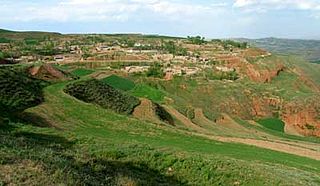
The Tibet Autonomous Region or Xizang Autonomous Region, often shortened to Tibet or Xizang, is an autonomous region of the People's Republic of China (PRC) in Southwest China. It was overlayed on the traditional Tibetan regions of Ü-Tsang and Kham.

Lijiang, formerly romanized as Likiang, is a prefecture-level city in the northwest of Yunnan Province, China. It has an area of 21,219 square kilometres (8,193 sq mi) and had a population of 1,253,878 at the 2020 census whom 288,787 lived in the built-up area (metro) made of Gucheng District. Lijiang is famous for its UNESCO Heritage Site, the Old Town of Lijiang, which contains a mixture of different historical architecture styles and a complex, ancient water-supply system.

The Tea Horse Road or Chamadao, now generally referred to as the Ancient Tea Horse Road or Chamagudao was a network of caravan paths winding through the mountains of Sichuan, Yunnan and Tibet in Southwest China. This was also a tea trade route. It is also sometimes referred to as the "Southern Silk Road" or "Southwest Silk Road."

Shigatse, officially known as Xigazê, is a prefecture-level city of the Tibet Autonomous Region of the People's Republic of China. Its area of jurisdiction, with an area of 182,000 km2 (70,271 sq mi), corresponds to the historical Tsang region of Tibet.

Ngawa Tibetan and Qiang Autonomous Prefecture, also known as Aba, is an autonomous prefecture of northwestern Sichuan, bordering Gansu to the north and northeast and Qinghai to the northwest. Its seat is in Barkam, and it has an area of 83,201 km2 (32,124 sq mi). The population was 895,200 by 2022.

Hainan Tibetan Autonomous Prefecture, formerly known as Tsolho Tibetan Autonomous Prefecture, is an autonomous prefecture of Northeastern Qinghai Province in Western China. The prefecture has an area of 45,895 square kilometres (17,720 sq mi) and its seat is located in Gonghe County. Its name literally means "south of (Qinghai) Lake."

Bairi Tibetan Autonomous County, also known as Tianzhu from its Chinese name, is in the prefecture-level city of Wuwei in the central part of Gansu province, China, bordering Qinghai province to the south and west. It has an area of 7,147 km2 (2,759 sq mi) and approximately 230,000 inhabitants (2003). Its administrative seat is Rabgyai Town (Huazangsi).
The SASM/GNC/SRC romanization of Standard Tibetan, commonly known as Tibetan pinyin or ZWPY, is the official transcription system for the Tibetan language in China. It is based on the pronunciation used by China National Radio's Tibetan Radio, which is based on the Lhasa dialect. It has been used within China as an alternative to the Wylie transliteration for writing Tibetan in the Latin script since 1982.

Litang is in southwest of Garzê Tibetan Autonomous Prefecture, Sichuan, China.

Tsona City, formerly Tsona County, is a county-level city in Shannan Prefecture in southern part of the Tibet region of China. Tsona means "The face of the [Nara Yumco] lake" in Tibetan. It lies immediately to the north of the McMahon Line agreed as the mutual border between British India and Tibet in 1914. China has not accepted the 1914 border delineation, but treats it as the Line of Actual Control (LAC). Tsona also borders Bhutan on its southwest.

Taktser or Tengtser or Hongya Village is a village in Shihuiyao Township, Ping'an District, Haidong, in the east of Qinghai province, China,. Tibetan, Han and Hui Chinese people populate the village which is notable as the birthplace of the 14th Dalai Lama, Tenzin Gyatso.

Wen County or Wenxian is a county under the administration of the prefecture-level city of Longnan, in the southeast of Gansu province, China, bordering Sichuan province to the south and west. It has a land area of 4,994 square kilometers, and a population of 241,000 (2019), notably having the largest population of Baima people.

Visitors to the mainland of the People's Republic of China must obtain a visa from one of the Chinese diplomatic missions unless they are citizens of one of the visa-exempt countries. The residents of Hong Kong, Macao, and Taiwan with Chinese nationality may stay in Mainland indefinitely as long as their travel documents are valid.

Wudu District is a district and the political and cultural centre of Longnan, Gansu province, China. It borders the provinces of Shaanxi and Sichuan to the southeast. It has a population of 590,000, of which 110,000 live in the urban area.

Datong Hui and Tu Autonomous County, Datong County, or Serkhog County is an autonomous county of Hui and Tu peoples in Qinghai Province, China. It is under the administration of the prefecture-level city of Xining, the capital of Qinghai.

Libo County is a county of southern Guizhou province, China, bordering Guangxi to the south. It is under the administration of the Qiannan Buyei and Miao Autonomous Prefecture.
Basum is a divergent Bodish language spoken by about 2,500 people in Gongbo'gyamda County 工布江达县, Nyingtri Prefecture, Tibet, China. Basum is spoken by 13.5% of the population of Gongbo'gyamda County. Glottolog lists Basum as unclassified within Bodish.

The Ministry of Culture and Tourism of the People's Republic of China (中华人民共和国文化和旅游部) is a constitute department of the State Council of the People's Republic of China in charge of culture and tourism.
Urumqi Glacier No.1 or Urumqi River Glacier No.1, Tianshan Glacier No.1, is the glacier closest to an urban area in the world, located only 120 km southwest to downtown Ürümqi, Xinjiang, China. As a major source of the Urumqi River, Glacier No.1 lies in the north slope of Tiangeer II Peak in the middle section of Tian Shan and it is within Ürümqi County.

Tenzing Tsondu, known professionally as Ding Zhen, is a Tibetan singer, Internet celebrity and businessman from Litang, Sichuan Province, China.




















